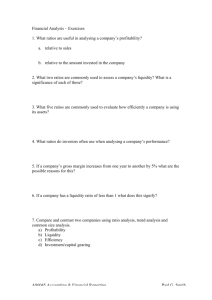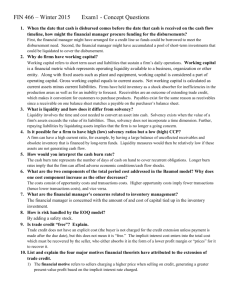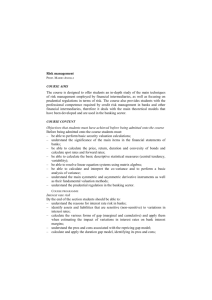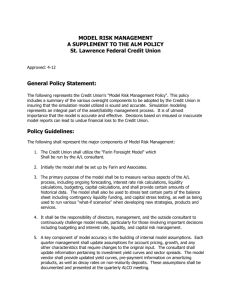The New Look for the Balance of Payments
advertisement
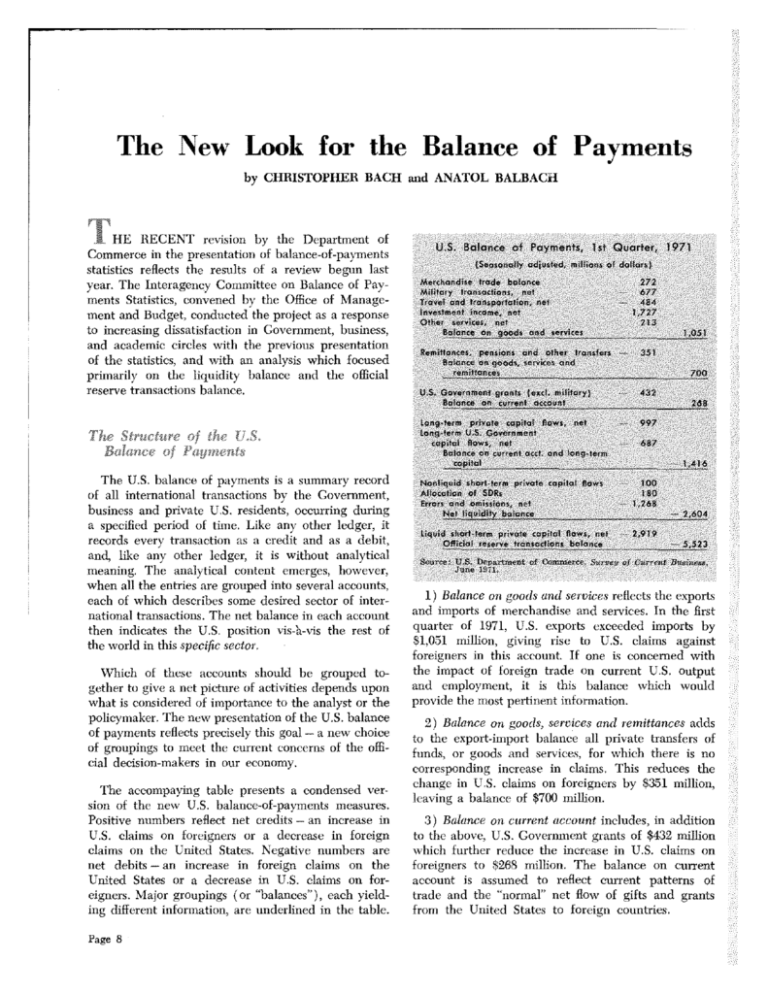
The New Look for the Balance of Payments by CHRISTOPHER BACH and ANATOL BALBACH THE RECENT revision by the Department of Commerce in the presentation of balance-of-payments statistics reflects the results of a review begun last year. The Interagency Committee on Balance of Payments Statistics, convened by the Office of Management and Budget, conducted the project as a response to increasing dissatisfaction in Government, business, and academic circles with the previous presentation of the statistics, and with an analysis which focused primarily on the liquidity balance and the official reserve transactions balance. The Structure of the [LS~ Balance of Payments The U.S. balance of payments is a summary record of all international transactions by the Government, business and private US. residents, occurring during a specified period of time. Like any other ledger, it records every transaction as’’a credit and as a debit, and, like any other ledger, it is without analytical meaning. The analytical content emerges, however, when all the entries are grouped into several accounts, each of which describes some desired sector of international transactions. The net balance in each account then indicates the U.S. position vis-h-vis the rest of the world in this specific sector, Which of these accounts should be grouped together to give a net picture of activities depends upon what is considered of importance to the analyst or the policymaker. The new presentation of the U.S. balance of payments reflects precisely this goal a new choice of groupings to meet the current concerns of the official decision-makers in our economy. — The accompaying table presents a condensed version of the new U.S. balance-of-payments measures. Positive numbers reflect net credits an increase in U.S. claims on foreigners or a decrease in foreign claims on the United States, Negative numbers are net debits an increase in foreign claims on the United States or a decrease in US. claims on foreigners. Major groupings (or “balances”), each yielding different information, are underlined in the table. — — Page 8 U.S. Balance of Payments, 1st Quarter, 1971 (Seasonally adjusted, millions of dollars) Merchandise trade bolance Military transactions, not Travel and transportation, nat nvestmont income, net Other services, nat Balance on goods and services 272 677 484 1,727 21 3 1,05! Remittances, pensions and other transfers Batancv on goods. services and remittances 351 U.S. Government grant Cent, military) Balance on cu.rent account 432 Lang’term private capstal flows, no? Lang-term U.S. Government capilal flaws, net Balance on c..rrent 0cc! and lang.term capital 997 700 2dB 687 1,416 Nontiqurd shart-term private capital flaws Allocation of SDRs Errors and omissions, nit Net liquidity balance 100 ISO 1266 Liquid strait-term private capitol flaws, net Official reserve tronsoclionu balance - 2,919 IS JJsT’a.lm,’nt .l:s,.u i’dl. • i’in:i,sr.’-c .Ca,r.q.J, 2,604 5323 - I rut, it fle,:,,..,.. 1.1 Ba/once on goods told .wiiu’c.s reflects tilt’ c.xporls and imports of merchandise and services. In the first quarter of 1971, U.S. exports exceeded imports by $1,051 million, giving risc to U.S. claims against foreigners in this account. If one is concerned with the impact of foreign trade on current U.S. output and employment, it is this balance which would provide the most pertinent information. 2) Balance on goods, services and remittances adds to the export-import balance all private transfers of funds, or goods and services, for which there is no corresponding increase in claims, This reduces the change in US. claims on foreigners by $351 million, leaving a balance of $700 million. 3) Balance on current account includes, in addition to the above, U.S. Government grants of $432 million which further reduce the increase in U.S. claims on foreigners to $268 million. The balance on current account is assumed to reflect current patterns of trade and the “normal” net flow of gifts and grants from the United States to foreign countries. FEDERAL RESERVE SANK OF ST. LOUIS 4) Balance on current account and long-term capital is frequently referred to as the “basic balance.” In addition to the balance on current account, it includes long-term capital flows and is used to measure longrun balance-of-payments positions. Except for U.S. military transactions and U.S. Government grants, it responds primarily to market forces consisting of price differentials and investment opportunity differentials among trading economies. As such, it reflects tastes and preferences of consumers, efficiency of producers, and the time preference of all decisionmaking units. If one is primarily concerned with the international flows of resources, with the benefits derived from international commerce, with the impact of international trade on domestic income and production, or with estimates of long-run movements in exports and imports, one would use the “basic balance” as a yardstick and as a tool for analysis. In the first quarter of 1971 this balance was $—1,416 million, indicating that, although U.S. exports exceeded U.S. imports by $1,051 million, gifts and remittances abroad and net purchases of foreign capital by U.S. residents increased foreign claims on U.S. dollars by the amount of the balance. 5) Net liquidity balance measures the change in liquid assets or liabilities generated during the period under consideration. The balance on current account and long-term capital indicates that U.S. net liabilities increased by $1,416 million. In addition, U.S. residents bought nonliquid short-term foreign capital valued at $100 million and errors and omissions amounted to $1,268 million. Private nonliquid short-term capital moves primarily in response to short-term interest rate differentials, and, although these movements are market-induced, were not included in the “basic balance.” Short-term interest differentials are temporary and readily reversible, so that they create enough volatility in these capital movements to make them incompatible with long-mn or “basic” concepts. At any point in time when the balance of payments is computed, there are transactions which escape detection and classification into the above-mentioned “balances.” There are normal errors in reporting, lags associated with items in process of collection, and some private transactions, frequently in Eurodollars, which cannot be detected under present reporting procedures. When total reported credits and debits are compared, any net difference represents errors and omissions and a change in claims against the dollar. AUGUST 1971 During the first quarter of 1971, the United States received its quarterly allocation of SDRs of $180 million which reduced liquid liabilities outstanding. Therefore, net liquid liabilities generated amounted to $2,604 million. 6) The official reserve transactions balance records the net change in U.S, monetary reserve assets plus the net change in liquid and certain nonliquid liabilities to foreign official agencies. This balance indicates the direct pressure which may be exerted by official agencies on U.S. gold and other official reserves, or the foreign exchange rate. The net liquidity balance shows that total foreign liquid claims increased by $2,604 million in the first quarter of 1971. In addition, private foreign individuals and banks reduced their short-term liquid capital holdings in the U.S. by another $2,919 million. Because foreigners, as a group, can reduce theft balances only by transfer to official agencies, there has been an increase in U.S. liabilities to these agencies of $5,523 million; $2,604 million which were incurred during the first quarter of 1971 and an additional $2,919 million as private foreigners reduced theft previously accumulated liquid claims. RevWons in the Liquidity Balance and Private Short-Term Capital More important than the Department of Commerce’s attempt to focus attention on several balances was their decision to reclassify liquid assets of the private short-term capital account. Under previous methods of reporting the liquidity balance, private short-term liquid liabilities were recorded as an item which “financed” (settled) a deficit or surplus once it had been incurred, while short-term liquid assets were considered an item which created a surplus or deficit. Under the new method of presentation, private shortterm liquid liabilities and private short-term liquid assets are treated similarly, and both are entered as items which “finance” the liquidity balance. U.S. Balance of Payments P’eviaus Mirthod Present Method Private Short.Tern, Capital Account Nonliquid Assets Liabilities Liquid Assets Private Shart.Term Copitol Account Nonliquid Assets Liabilities Liquid Liobilitier Liquid Liobililies Liquid Assets ‘list’ sigisilic:tiict’ (If tilt’ (liSlilst’tit)Il 1)(’t\Vt’(II t’sits’rixig liquid assets as part of the short-term capital account Page 9 FEDERAL AUGUST RESERVE SANK OF ST. LOUIS and entering liquid assets with liquid liabilities as a means of financing the liquidity balance can be seen in the following example. If an American Bank and a foreign bank exchange deposits of $100 by crediting each other’s account, the transactions entered on the U.S. balance-of-payments statement under the old system of accounting would show an outflow of capital without any offsetting inflow of capital. The rise in the American bank’s assets abroad would appear above the dotted line with a minus sign as a factor contributing to the balance-of-payments deficit, while the rise in the foreign bank’s deposits in the United States would appear below the dotted line with a plus sign as a means of “financing,” but not offsetting, the deficit. Instead of a zero liquidity balance, the statement records a liquidity deficit of $100. Under the present method of presentation, the exchange of deposits would cancel out and the accounts would show a liquidity balance of zero. Certain Nonliquid Liabilities to Foreign Official Agencies Another change in the presentation of the liquidity balance was to reclassify items grouped as certain nonliquid liabilities to foreign official agencies from a nonliquid to a liquid category. This group of long-term liabilities of U.S. banks and the Government was entered in the previous presentation with other nonliquid items in the Government and private capital accounts. In the new presentation they are considered a financing item and, like other private short-term liquid assets and liabilities, do not affect the liquidity balance. U.S. Balance of Payments Prevous Method Present Method certain Nontiquid Liobilities to Foreign Officiot Agencies Certain Nonliquid Liobilities to Foreign Official Agencies U.S. Balance of Payments Previous Method Present Method iiic~c nOuhilhdlV uorshc uid long—tersn liabilities arc 1 Private Shart.Term Liquid Assets $100 Liquidity Balonce $100 Pr,vote Short-Term Liq uid Liabil tics - 100 Liquidity Bolonce P’ivate Short-Term Liquid Assets -- $ 0 $100 Private Shorl.Term Liquid Liabilities 100 The same type of problem would occur if banks of only one country were involved. Interbank transfers of funds that shifted deposits from parent banks in the U.S. (liquid assets of Americans) to branches of U.S. banks located abroad (liquid liabilities to foreigners) would be recorded in the same manner as the above example. Both types of capital movements have reduced the usefulness of the liquidity balance in recent years by producing large, temporary swings in the liquidity balance when there were at least partially offsetting capital movements. The new method of presentation eliminates the artificial distinction between American and foreign short-term liquid assets and liabilities and thereby relates the short-run behavior of the liquidity balance more closely to the actual external liquidity position of the United States. However, because many short-term capital movements are recorded as errors and omissions which appear above the dotted line, there will continue to be a large divergence between the measured and actual external liquidity positions. Page 10 1971 issued for the purpose of reducing liquid dollar holdings of foreign official agencies, and generally carry with them a provision for convertibility to liquid form. In essence they simply provide another way for foreign central banks to hold accumulated liquid assets. When recorded as a nonliquid capital inflow under the previous method, they reduced recorded liquid liabilities of the U.S. and thereby, the measured liquidity deficit, while in reality there was little, if any, decline in liquid claims on the dollar. The new method eliminates this artificial reduction in the liquidity deficit. Comnarison of Alternative Liquidity Balances The accompanying charts compare the gross liquidity balance (previous presentation) with the net liAlternative Balance of Payments Measures Rit.inn; nI flnin’c - Bili onc ef Doors L~/.\ Gross Liquidity Balance(old) j 1” •~ Net tsquidtly 6etancelnew~ \2’~’ / / //\/////////// /‘/// /~//\///~//, — \ FEDERAL RESERVE SANK OF ST LOUIS AUGUST 1971 and 1968, when it made the net liquidity deficit larger than the gross liquidity deficit, and in 1969 and 1970 when it made the net liquidity deficit less than the gross. It is difficult to measure the impact of the change in the treatment of liquid assets (and in particular, net Eurodollar flows), because there is no direct data on many international capital flows. If available, such data would probably show a reduction in the net liquidity balance relative to the gross liquidity balance. quidity balance (present presentation). The patterns of both the quarterly and annual data for the periods available are quite similar to the old series and therefore do not require any major new analysis of the U.S. external liquidity position. The revised treatment of certain nonliquid liabilities had its most pronounced impact on the liquidity position in 1967 Since many short-term capital flows will continue to be entered in errors and omissions, the net liquidity balance will, in effect, continue to distinguish arbitrarily between short-term liquid assets and liabilities, leaving the net liquidity balance little changed from the old concept. In periods when short-term capital flows are large and unrecorded, there will continue to be a significant difference between the concept of net liquidity and the statistics purported to show it, Page 11



